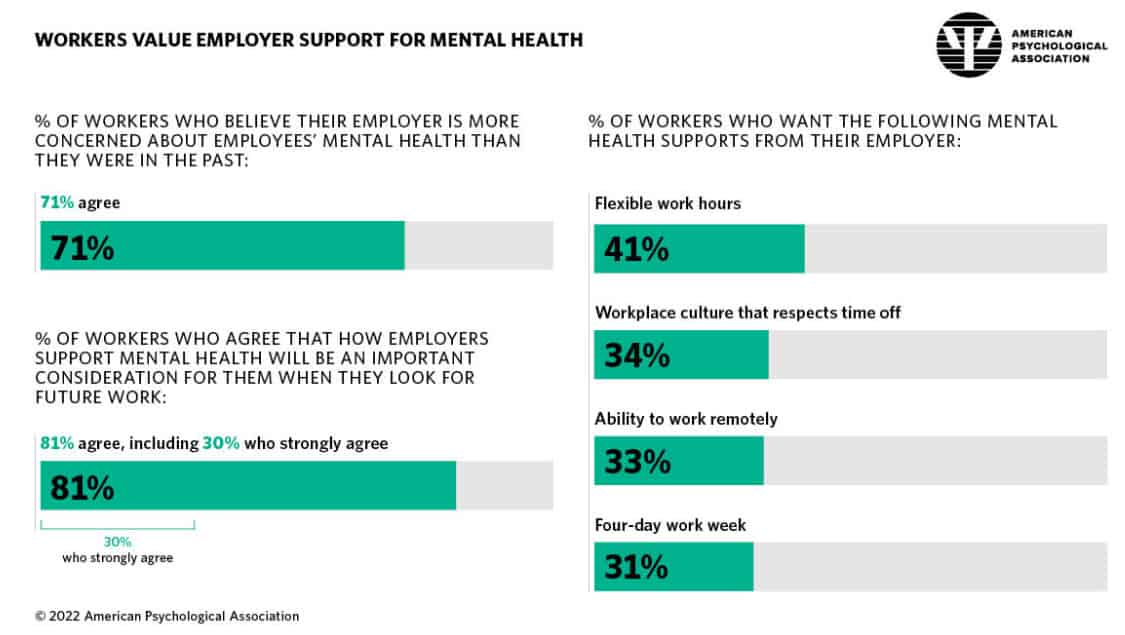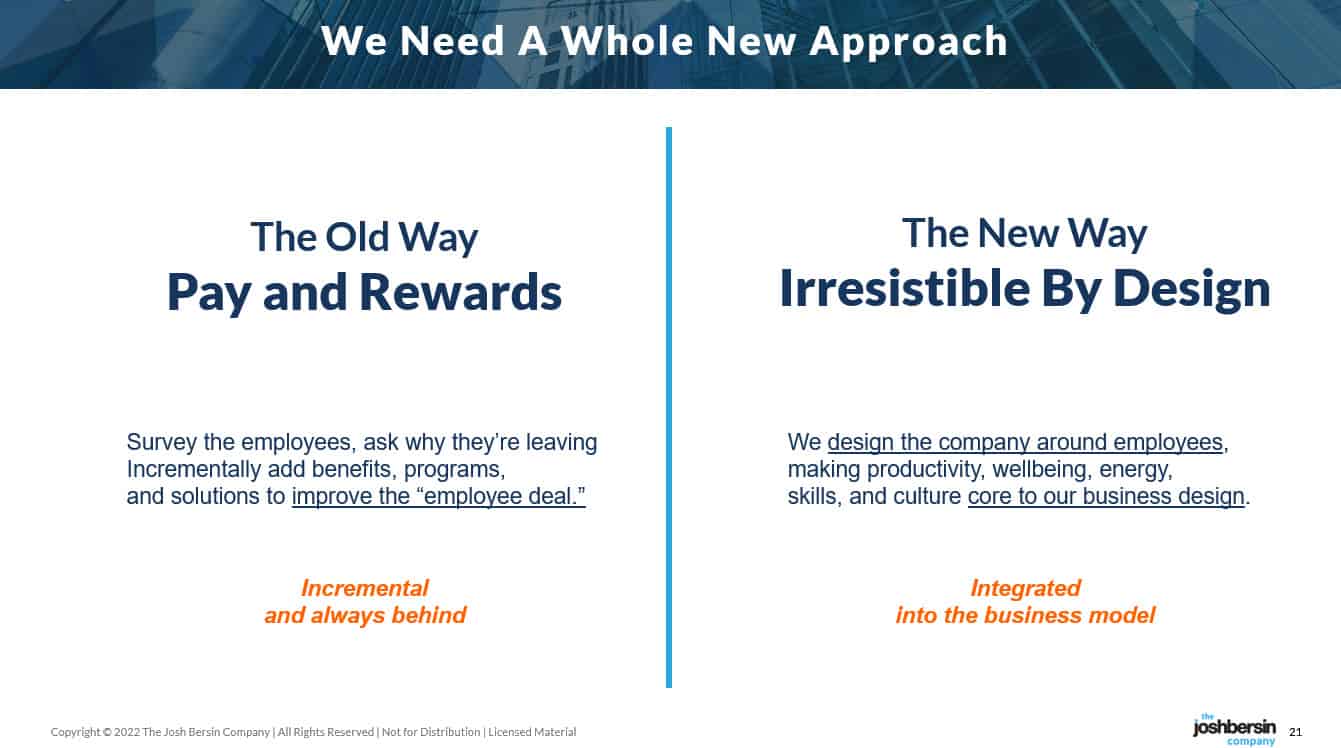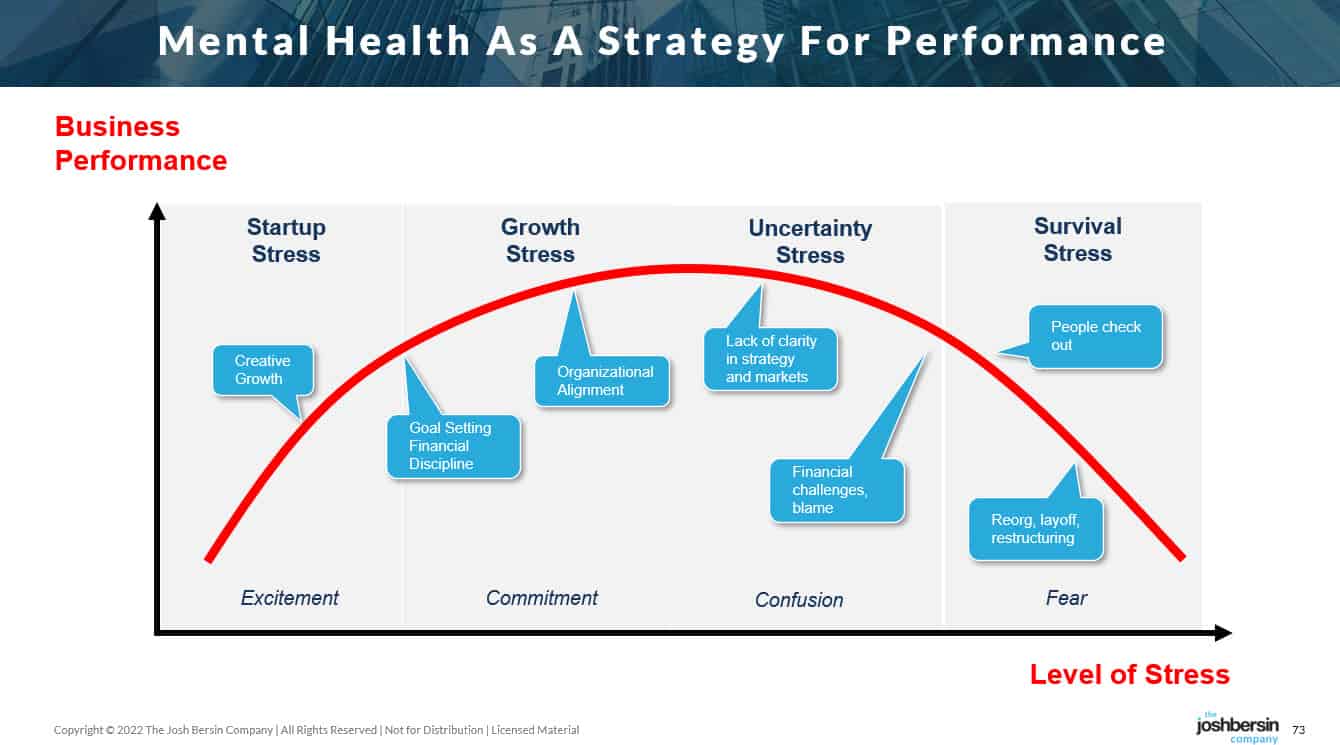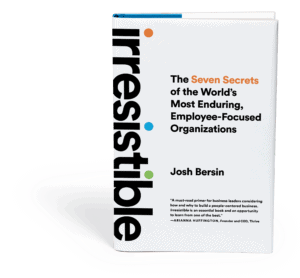Workplace Mental Health Has Become A Strategy For Business Performance
Here’s a shocking statistic: 15.8% of Americans now take regular medication for depression or anxiety, and it reaches 25% for those under the age of 30. And as of May this year, 39% of Americans experienced some form of anxiety or depression in the last four weeks.
Stress, anxiety, and depression are becoming the biggest health problems at work. How do I know? The latest global Mercer study found that 81% of workers are burned out. And new research by LifeWorks shows that Managers now have lower mental health scores than employees, indicating how difficult this period has been. (And the American Psychological Association believes the trauma of the pandemic will have long-lasting impact on employees.)
 |
How did we get here? The uncertainty of the pandemic, followed by inflation and a slowdown, coupled with relentless political unrest, has weighed upon us all.
We, as business people, have to think about this problem differently. Rather than think about mental health as a healthcare or benefits problem, perhaps we should think about it as a strategy. What if you, as a business, focused on mental health as your strategy to grow, innovate, and adapt?
In other words, rather than think about mental health as an illness or problem to solve, what if we designed our companies to be positive places at the start?
It isn’t a completely new idea, but it’s something I think every company should consider. I call it Irresistible by Design.
 |
How Workplace Mental Health Works
There are two elements to mental health at work: the individual and the organization.
At an individual level, we each have needs, aspirations, and phobias. As Maslow’s Hierarchy points out, when we feel safe and protected, we aspire for growth, meaning, and a higher purpose. If we feel threats at home or work (the pandemic, family issues, financial stress, or other), we worry, slow down, and check out.
I interviewed Marty Seligman (the father of positive psychology) on this topic a few years ago and he taught me a lot. In his studies of PTSD and stress in the military, he found that people under stress need to get away from the problem, feel joy and fun and laughter, and stop catastrophizing about risk.
In other words, turn off the news, get a dog, and go have some fun. As silly and superficial as that seems, it does make people feel better. So these kinds of activities are important.
This, by the way, is why company offsites, message boards, and clowning around can help. It changes the context of work and helps us deal with uncertainty.
Organization-Induced Stress
But what about the second side of the problem: stress induced by or amplified by the company? This gets into our organizational issues.
Consider the following chart, something I drew based on my own personal experience. It shows the relationship between business performance (on the vertical) and stress on individuals (across the horizontal). And it shows that there is an “optimum stress” for performance, above which bad things start to happen.
 |
In the early stages of a job or a business, we feel the stress of starting something new. We’re excited, a little apprehensive, but filled with optimism and ideas. Startups and new product teams have this kind of stress. We know there are risks and uncertainty, but we’re excited about the potential. (I remember feeling this way about every new project at Deloitte.)
As the business or company grows, the stresses get bigger and broader. Maybe we’re now a big team or large company, and we’re finding it harder to grow than before. The “law of big numbers” sets in and we get up each day and wonder “how are we ever going to hit those numbers!” I’ve been through this during my years at IBM, Sybase, and Deloitte – we feel this heightened need to perform, but wonder if we can pull it off.
As the chart shows, during this second phase we add stress and performance goes up. We learn how to work together, we challenge ourselves, we iterate on our products, and we find new growth.
But then something else happens. Our team, business, or company seems to plateau. Our competition caught us in the market; our product just hasn’t kept up; perhaps the economy just took a dive. And no matter how hard we try, we just don’t seem to hit our numbers, so we ratchet down our expectations.
Yet stress continues to go up. We end up on the downward sloping curve. More pressure, more confusion, more distraction. Next come layoffs, we start to play the blame game, and the team, company, or group has to rebuild itself.
 I’ve watched companies go through this process, and my HR colleagues are experts at dealing with it. During the down-sloping high-stress phase, leaders sometimes do the wrong thing. They “tighten the screws” on financial management, telling people to “do more with less.” They focus on people who aren’t hitting their goals and start a draconian performance management process. Or they bring in a bunch of consultants (watch the movie Office Space) to help make the tough decisions.
I’ve watched companies go through this process, and my HR colleagues are experts at dealing with it. During the down-sloping high-stress phase, leaders sometimes do the wrong thing. They “tighten the screws” on financial management, telling people to “do more with less.” They focus on people who aren’t hitting their goals and start a draconian performance management process. Or they bring in a bunch of consultants (watch the movie Office Space) to help make the tough decisions.
I lived this curve at Sybase early in my career. During the growth phase, I came to work every day nervous that I wouldn’t perform well, but we kept growing and everyone felt like a hero. We were beating Oracle every day and it felt like a team that could do no wrong.
Then, when Microsoft and Oracle caught up, the wheels fell off. We lost deal after deal and the product, marketing, and strategy suddenly seemed like a wreck. We must have had two years of “new initiatives” and all we felt was stress. One day the CEO (Mitchell Kertzman), who was a very entertaining comedian, made a speech that he was tired of running a company where everyone was “watching the train wreck,” challenging us to fix the problem. And all that did was dial up the stress worse, making it harder than ever to succeed. Despite his good humor, the company replaced the top management and eventually Sybase was sold.
Customers Also Create Stress
For many employees, it can even get worse. If your company does business with the public (retail, hospitality, transportation, food service, entertainment) employees are likely dealing with angry customers too. So mental health is a systemic issue, one we have to think about in our entire “people supply chain.”
Last week Starbucks closed down 16 stores because of crime and Kroger’s, McDonald’s, and others are doing the same. Your job is not to just force employees to deal with irate customers: give them the freedom to say no, get help, or simply walk away. As Starbucks CEO Howard Schultz put it, “we are not in the business of solving society’s ills: we just have to make our stores safe and purposeful for employees.” Mental health is part of this mission.
It Doesn’t Have To Be This Way
 We, as employers, can really make a difference. Before you push people down the right side of the curve, maybe you should think about the health and vitality of your people first. Instead of pushing for growth and innovation above all else, what if we ask people how they’re doing, give them a sense of safety, and let them come up with ideas for reinvention and growth?
We, as employers, can really make a difference. Before you push people down the right side of the curve, maybe you should think about the health and vitality of your people first. Instead of pushing for growth and innovation above all else, what if we ask people how they’re doing, give them a sense of safety, and let them come up with ideas for reinvention and growth?
I’ve watched Siemens, Bosch, Cisco, eBay, and other companies do this, and the results can be amazing. If you help people feel healthy and safe, they always come up with new ideas. And this approach is far better than pushing people to the right of the curve.
Note that pushing people hard can have devastating negative effects. In the fascinating study “Goals Gone Wild, The Systematic Side Effects of Over-Prescribing Goal Setting“, four Harvard professors point out how Sears, Enron, Ford, Coca-Cola, Continental Bank, and many others forced their companies into lawsuits or bankruptcy by pushing employees too hard. These stories are lessons to learn: when we put people under stress, they lose interest in the task or behave in unethical ways.
Teresa Amabile from Harvard, who has studied motivation and performance for decades, has concluded that innovation, productivity, and problem solving are directly related to intrinsic motivation. Stress caused by unachievable goals or micro-management reduces this source of power, driving companies down the right side of the curve.
One more example: what is the most successful high-stress organization in the world? The US Military. Soldiers are subjected to the ultimate stress: losing their lives. So the military spends billions of dollars on training, simulation, discipline, and fitness. Sleep, for example, is a major strategy for military readiness. So is a healthy diet. Sound familiar? (More on stress reduction in the military here.)
It All Comes Down To Leadership
Before you delegate the mental health issue to the benefits department, let me suggest something else. This is a responsibility of leadership (who also feel stressed out), so look at it as a strategy. If you, as a leadership team, can focus on mental health first, financial success will likely follow.
First, you have to look at yourself. Are you stressed out and are you causing others to feel worse? Are you taking care of yourself? Maybe it’s time to take a break, get a coach, or ask for some feedback.
Second, are you pushing too hard? Telling people to “do more with less” or “just suck it up” are precisely the strategies that cause harm. As the Harvard researchers point out, the more you push people the more errors and unethical behaviors you create.
Third, are you really a “Human-Centered” leader? As we write about in the Human-Centered Leadership research (we also have a course on Human-Centered Leadership in our Academy), every business problem can be considered a people problem. Can you avoid a layoff by reorganizing the team? Can you ask people to take a pay cut and empower them to come up with new ideas? Can you figure out why a group is underperforming without punishing the team?
All these ideas come down to leadership, and that falls on you.
We just finished a webinar with Heather Yurko, the head of digital talent at Mastercard, and she told us that their new talent marketplace, which lets employees find projects they want to work on, created more than $21 Million of net-new productivity in the first six months. This “unleashed energy” was purely a result of giving people the opportunity to work on things they wanted, and enabling them to feel “freedom” to find the right role at Mastercard.
Listen, mental health is a real and serious issue at work. People with anxiety, depression, OCD, and other ailments are truly suffering. But rather than think about this as a “health problem to be solved,” it’s time to go deeper and look at mental health as a strategy. Regardless of your business environment, if you unleash the intrinsic power in each individual, I promise you’ll see performance (and happiness) as a result.
Additional Information
Irresistible by Design: The Winning Strategy For Today
Apple Announces Integrated Health Strategy For Its Products
How Work Design And Job Design Are Holding Companies Back
Unleashing Human Potential: The Real Secret To Business Success


